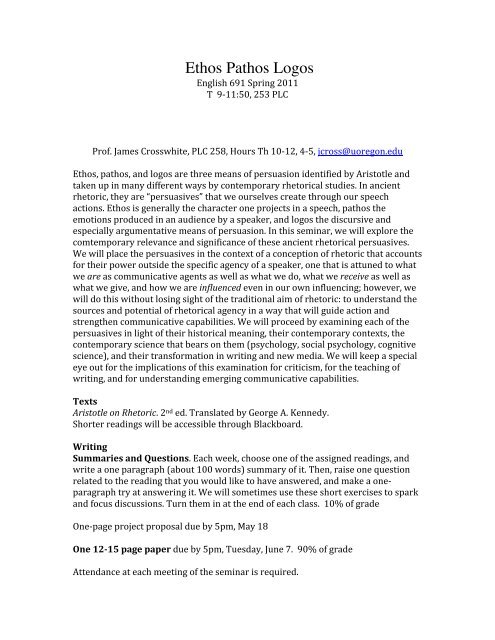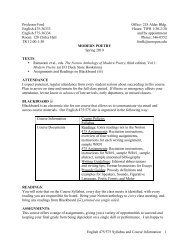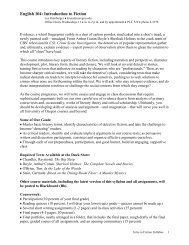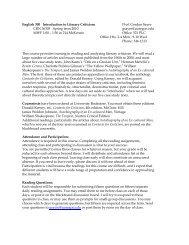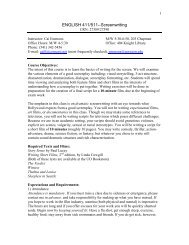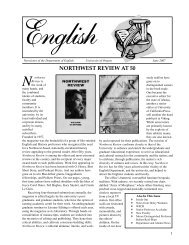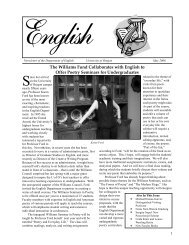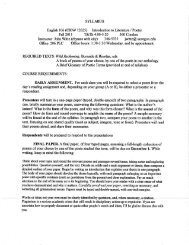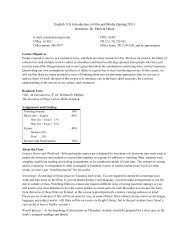Eng 691 spr 11 ethos pathos logos
Eng 691 spr 11 ethos pathos logos
Eng 691 spr 11 ethos pathos logos
- No tags were found...
Create successful ePaper yourself
Turn your PDF publications into a flip-book with our unique Google optimized e-Paper software.
Ethos Pathos Logos<strong>Eng</strong>lish <strong>691</strong> Spring 20<strong>11</strong> T 9-‐<strong>11</strong>:50, 253 PLC Prof. James Crosswhite, PLC 258, Hours Th 10-‐12, 4-‐5, jcross@uoregon.edu Ethos, <strong>pathos</strong>, and <strong>logos</strong> are three means of persuasion identified by Aristotle and taken up in many different ways by contemporary rhetorical studies. In ancient rhetoric, they are “persuasives” that we ourselves create through our speech actions. Ethos is generally the character one projects in a speech, <strong>pathos</strong> the emotions produced in an audience by a speaker, and <strong>logos</strong> the discursive and especially argumentative means of persuasion. In this seminar, we will explore the comtemporary relevance and significance of these ancient rhetorical persuasives. We will place the persuasives in the context of a conception of rhetoric that accounts for their power outside the specific agency of a speaker, one that is attuned to what we are as communicative agents as well as what we do, what we receive as well as what we give, and how we are influenced even in our own influencing; however, we will do this without losing sight of the traditional aim of rhetoric: to understand the sources and potential of rhetorical agency in a way that will guide action and strengthen communicative capabilities. We will proceed by examining each of the persuasives in light of their historical meaning, their contemporary contexts, the contemporary science that bears on them (psychology, social psychology, cognitive science), and their transformation in writing and new media. We will keep a special eye out for the implications of this examination for criticism, for the teaching of writing, and for understanding emerging communicative capabilities. Texts Aristotle on Rhetoric. 2 nd ed. Translated by George A. Kennedy. Shorter readings will be accessible through Blackboard. Writing Summaries and Questions. Each week, choose one of the assigned readings, and write a one paragraph (about 100 words) summary of it. Then, raise one question related to the reading that you would like to have answered, and make a one-paragraph try at answering it. We will sometimes use these short exercises to spark and focus discussions. Turn them in at the end of each class. 10% of grade One-‐page project proposal due by 5pm, May 18 One 12-15 page paper due by 5pm, Tuesday, June 7. 90% of grade Attendance at each meeting of the seminar is required.
3 May 3 Aristotle’s Rhetoric: Ethos and Pathos II May 10 Transitions: Public Sphere Theory May 17 Logos and Enthymeme: Questions and Challenges May 24 Aristotle’s Rhetoric: Style and The Persuasives 1. Aristotle on Rhetoric: Book Three 2. “Aristotle and Theories of Figuration” by Jeanne Fahnestock. 3. Sections on Presence , Style, and Figures from The New Rhetoric by Chaim Perelman and Lucie Olbrechts-‐Tyteca. 4. “No Neutral Choices: The Art of Style in The New Rhetoric” by Jeanne Fahnestock May 31 Project Reports Final paper due anytime before and up until 1pm Thursday, June 9. Just slide the paper under the door at 258 PLC.


